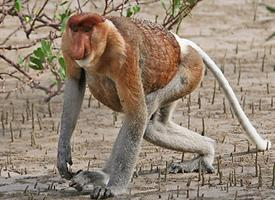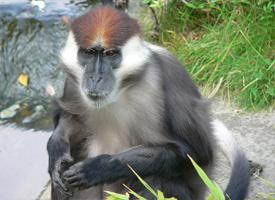
Súlyok és méretek
| Marmagasság | 60-tól 75-ig cm |
|---|---|
| Súly | 10-tól 24-ig kg |
Állatleírás
The Proboscis monkey (Nasalis larvatus), also known as the long-nosed monkey, is a distinctive species of primate that is native to the island of Borneo in Southeast Asia. This remarkable animal is most notable for its large, pendulous nose, especially prominent in males. The unique physical characteristics, behavior, and habitat of the Proboscis monkey make it a fascinating subject of study and a symbol of Borneo's rich biodiversity.Physical Description:
The Proboscis monkey is a large species among the Old World monkeys, with males significantly larger than females. Males can weigh up to 24 kilograms (53 pounds), while females are much smaller, averaging around 12 kilograms (26 pounds). The most striking feature of the Proboscis monkey is undoubtedly the male's large, bulbous nose, which can exceed 10 centimeters (4 inches) in length. This nose is thought to play a role in amplifying vocalizations and attracting females. Both sexes have a pot-bellied appearance due to their specialized stomachs necessary for digesting their leaf-based diet. Their fur is a reddish-brown color on the back and shoulders, turning to grey, yellow, and white on the underparts. They have long, white tails and partially webbed feet, adaptations for their semi-aquatic lifestyle.
Habitat and Distribution:
Proboscis monkeys are endemic to the island of Borneo, found in mangrove forests, swamps, and coastal areas. They are highly dependent on these wetland habitats, which are unfortunately under threat from deforestation and habitat destruction. The monkeys are excellent swimmers, using their webbed feet to escape predators and to move between fragmented patches of forest.
Diet:
The diet of the Proboscis monkey is predominantly folivorous, consisting mainly of leaves, along with fruits, seeds, and flowers. They have a complex, multi-chambered stomach that allows them to ferment and break down the cellulose in leaves. This specialized digestive system makes them one of the few primates capable of digesting such a high-fiber diet, but it also limits the range of foods they can eat and makes them highly dependent on their forest habitat.
Behavior and Social Structure:
Proboscis monkeys are diurnal and arboreal, spending most of their time in the trees. They live in organized social groups, usually consisting of a single dominant male, multiple females, and their offspring. These groups are known as harems. There are also all-male groups, consisting of younger males and older males who have lost their harems. The monkeys communicate using a variety of vocalizations, facial expressions, and postures. Their social structure and communication methods are complex and are still being studied by primatologists.
Conservation Status:
The Proboscis monkey is listed as Endangered on the IUCN Red List of Threatened Species. The main threats to their survival are habitat loss due to logging, palm oil plantations, and human settlement, as well as hunting in some areas. Conservation efforts are underway to protect the remaining populations, including habitat preservation and the establishment of protected areas. However, the future of the Proboscis monkey remains uncertain without continued and increased efforts to conserve their natural habitats and mitigate threats.
In conclusion, the Proboscis monkey is a unique and fascinating primate, both in appearance and behavior. Its dependence on Borneo's threatened mangrove and swamp forests highlights the importance of conservation efforts in this region. As a flagship species for Borneo's biodiversity, the Proboscis monkey plays a crucial role in drawing attention to the need for environmental protection and sustainable management practices in the region.
Hasonló állatok
Új állatfotók
Top 10 állat
- Dolphin gull (Leucophaeus scoresbii)
- Diana monkey (Cercopithecus diana)
- Japanese macaque (Macaca fuscata)
- Galápagos tortoise (Geochelone nigra complex)
- Stone loach (Barbatula barbatula)
- Moustached guenon (Cercopithecus cephus)
- Russian tortoise (Testudo horsfieldii)
- Common house mosquito (Culex pipiens)
- Japanese spider crab (Macrocheira kaempferi)
- Giant peacock moth (Saturnia pyri)


